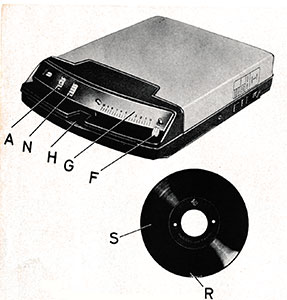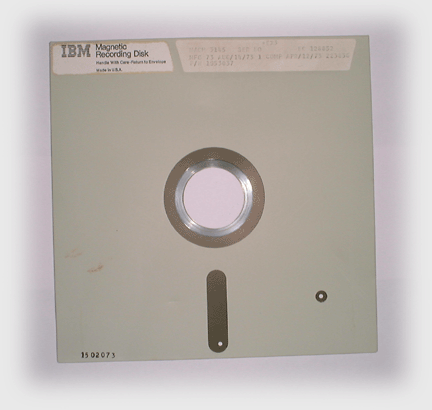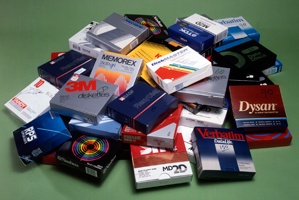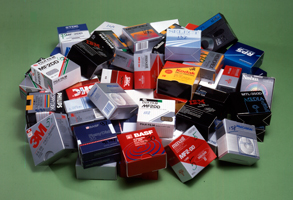8 inch floppy disks

Telefunken Diktatgerät (1962)
The 8" floppy disk (diskette) - the progenitor of this family of flexible magnetic media - was introduced by IBM in the late 1960's, inspired by the flexible, self-centering magnetic disk used by Telefunken in its dictation recorder [5]. The Telefunken disk was grooved like a gramophone record, and was not permanently enclosed in a jacket like the floppy disk.

IBM 370/145 microcode disk (1973)
A diskette is divided in tracks radially and sectors angularly. There are three ways of defining sectors:
- soft sectoring, index recording: an index signal, once each revolution (1/6 sec), marks the beginning of a track. The signal is generated by light passing through a hole near the inner edge of the disk;
- soft sectoring, alternative: the beginning of a track start is identified by a recorded special bit pattern;
- hard sectoring, defined by optical index signals per revolution. The IBM diskette shown here has 8 index holes. It is a 370/145 microcode disk, with the index holes located differently from the later 3740 standard for general data storage applications.
Originally, diskettes couldn't be protected from being accidentely erased or overwritten. Later on a write-protection notch was introduced. This notch could be closed by gluing a piece of light-tight tape over it. For compatibility reasons, it was obvious to define the open-notch situation as write-protected (later, 5.25 inch diskettes used the opposite convention). Obviously an open write-protect notch was only effective in floppy drives equipped with the appropriate optical sensor.
Details of recording formats are given in [1].
Examples
Disk formats supported by the Matrox FFD-1 Floppy disk controller [8]:

IBM standard format [3]
- disk diameter 19.7 cm (7¾").
- SD (IBM 3740 format) uses FM coding; DD (IBM System 34) uses MFM (except for track 0 which is written in FM)
- standard data rates 250 kbit/s (FM), 500 kbit/s (MFM)
- 360 rpm
- 26 sectors/track; 73 data tracks, 1 index track, 2 spare tracks, 1 reserved track
- 128 bytes/sector
- total disk capacity 3203128 bits (242944 bytes of data with this format)
CP/M standard format [6]
- conforming to IBM standard SD/SS,
- soft sectored 77 tracks, 26 sectors per track, sector contains 128 data bytes
- block size (smallest amount of data that can be allocated) 1024 bytes (1 kbyte)
- disk capacity 241 blocks of data + 2 directory blocks
Nova 3 floppy disk [4]
- 1 recording surface (SS)
- Formatted capacity 512 bytes/sector, or 4096 bytes/track (48 tracks per inch, 77 tracks)
- Total surface capacity 315392 bytes
- 32 hard sector address verification holes
- Average transfer rate 25 kbytes/sec Average latency 83.33 ms, average head pos time 260 ms
- recording technique FM
Digital Equipment Corp. RX01 [7]
- SS/SD, soft sectored 77 tracks, 26 sectors per track, 2002 sectors per diskette, 128 bytes per sector
- capacity 256,256 bytes
- 48 tracks per inch
- bit density 3200 bits/inch at inner track
Digital Equipment Corp. RX02 [7]
- SS/DD, soft sectored 77 tracks, 26 sectors per track, 2002 sectors per diskette, 256 bytes per sector
- capacity 512,512 bytes
- 48 tracks per inch
- bit density 6400 bits/inch at inner track
Radio Shack TRS80 Model II [9]
- SS/SD, soft sectored 77 tracks, 26 sectors per track, 256 bytes per sector (track 0 128 bytes per sector)
- capacity 509,184 bytes per diskette
- data transfer rate 500,000 bits/second except track 0 (250,000 bps)
- see [9] for the many pecularities of the way the TRSDOS operating system uses the disk space!
Abbreviations
- SD / DD: single / double density
- SS / DS: single / double sided
- HD: high density
- FM: frequency modulation ('double frequency')
- MFM: modified FM
- rpm: revolutions per minute


For extensive information about floppy disks in general, see Wikipedia: Floppy disk. Photos [EJ].
References
[1] J.D. Lenk: Handbook of microprocessors, microcomputers and minicomputers. Prentice-Hall 1979.[2] Proc IEEE 74(1986) #11 , special section on magnetic information storage technology.
[3] B. Wilkinson, D. Horrocks: Computer peripherals. Hodder& Stoughton (London) 1980.
[4] Data General Diskette Subsystem 6030/31 Product Brief.
[5] E.W. Pugh e.e.: IBM's 360 and early 370 Systems MIT Press 1991.
[6] A.R. Miller: Mastering CP/M. Sybex 1983.
[7] Microcomputer interfaces handbook. DEC 1980.
[8] Matrox FFD-1 Floppy disk controller manual, 1981.
[9] TRS80 Model II Disk Operating Reference Manual, Radio Shack 1979.
rev. February, 2017
